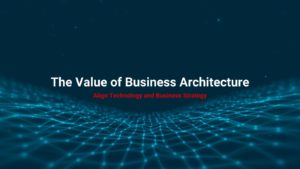How Can We Create an Architecture That’s Built to Last Because It’s Designed for Change?
This is the third part of an ongoing series, where I’m using the framework of WHY, WHAT, HOW, WHO from my book Blind Spot: A Leader’s Guide To IT-Enabled Business Transformation – enhanced with stories and analogies – to help business leaders to understand the Digital and IT transformation journey in very simple business terms. The strategy (the WHY and the WHAT) to compete in the modern era is the responsibility of the entire executive team, however, the CIO, CFO, and the CHRO have unique roles in enabling execution. I hope to give the IT leaders in our community an easy language to share with their business partners, especially in Finance and HR, to help broaden the dialogue and create the leadership alignment necessary to accelerate the transformation.
The crisis of the last few months should have clarified WHY we need to change, and that the time is NOW (Part 1). Only a few senior leaders are still wondering about or resisting that premise. One real challenge, for the entire executive team, is to think about WHAT will make us faster and more flexible, which is “Business Agility” (Part 2). Of equal importance, this time, HOW we architect and build modern systems matters – a lot – because we can’t have Business Agility if we keep adding to our Technical Rigidity.
Part 3: Changing HOW the Technology is Built
Most of us have inherited systems, processes, and data structures that have institutionalized fragmentation and hardwiring, leading to a rigid and complex legacy base. In most companies, little of what we’ve built in the past has gone away. We just kept building more and adding to the complexity. These legacy systems have made our businesses successful over the decades. But they’ve also had the unintended consequences of making us slow, expensive, risky, and inflexible. Now, most companies are investing in some new innovative solutions that center around the digital demands of the changing marketplace, and that’s great. However, HOW they are typically architecting and building the connections of those new solutions to the existing transaction systems and data is making the foundation even slower, riskier, more expensive, and more rigid – even brittle or fragile.
It’s time to major in not just WHAT we build but also HOW we build it. This time we have to design our technology architecture in a different, more disciplined way that enables three major kinds of agility.
Technology Agility – Built for Continuous Renewal
- the ability to continuously and seamlessly keep the technology assets – applications, platforms, infrastructure, etc. – flexible, up to date, high performing, low risk, and cost-efficient without piling up “technical debt” that needs to be paid down with large, distracting, and costly spikes in investment
- enabled by a layered architecture that’s loosely coupled and engineered to allow for change in layers to occur at different frequencies and speeds based on technology innovation, without disruption of the business systems that those layers support
Strategic Agility – Built to Reconfigure the Business
- the ability to quickly and effectively change strategy, requiring new, enhanced, and/or cross-functionally integrated business capabilities and/or altogether new capabilities
- enabled by reusable components and flexible business rules that can be assembled and/or configured without allowing an “IT project” to be the long task in the plan or the IT investment to be the constraint that prevents timely execution
Tactical Agility – Built for Dynamic Response to Marketplace Events
- the ability to sense-and-respond in the moment and in very specific situations on the front-line of engagement with customers, employees, suppliers, and partners
- enabled by the perfect real-time alignment of the physical and digital state of the business and applied in human and machine to dynamically impact business rules (e.g. a spike in demand that warrants an increase in price – think Uber “surge pricing”)
Architecting and creating for these kinds of agility is now within reach, given the continuing and accelerating advance of technology innovation. However, for established Fortune 500 companies with long histories and legacy systems bases, getting from Technical Rigidity to Technical Agility will require a thoughtful, disciplined, multi-year journey. And, that’s hard because it’s hard.
What got us HERE (decades of functional excellence in silos and straightforward scaling) won’t get us THERE (a dynamic future that requires “Business Agility”). So, it’s time to bite the bullet and deal with it.
How We Got HERE: The Vicious Cycle
It’s important to understand how this evolution to Technical Rigidity has happened over time and, in most companies, continues today. This has happened one project at a time, one budget year at a time, and one “good” decision at a time. CIOs and CFOs and Boards of Directors have set up a financial and planning game that can’t be won if the goals are things like “omnichannel customer experience”, “segment of one personalization”, “supply chain optimization”, “bending the cost curve”, etc. These strategic themes all span multiple functional areas and require multi-year investments – and they all relate to and depend on each other. The most important business goals are difficult to accomplish with project-by-project, annual budget-driven approach to technology architecture. Moreover, the Business Agility to continuously transform on those dimensions will be impossible.
With the current, common approach, it never feels like the right budget year to spend the time and money to update or re-architect aging infrastructure or those older but critical applications that have hardcoded business rules, logic, workflow, data, and processes. Each year, during the Annual Operating Plan or budgeting season, we have overwhelming business demand to buy or build new capabilities within a single function or department or business unit. Those functional executives have long lists of project demands they want IT to address immediately, in part because there’s business urgency and in part because they’ve already waited years for some of those projects. And, when we do get asked to enable cross-functional or cross-business-unit integration for big initiatives like Customer Experience or Supply Chain Optimization or New Products or New Markets, the time and budget constraints push us toward finding short-cuts to hardwire functional systems together, with expediency winning out over building things the right way. This just makes our technology even more complex, expensive, rigid, and risky. These dynamics are not new. Here’s how I’ve seen them play out over time, time after time, when companies grow fast without thinking about their architecture and designing for the change that they need.
First: Functional Excellence
The way companies built their competitiveness over the Industrial Era was through functional excellence (Frederick Winslow Taylor) and continuous improvement (Six Sigma). So, the initial productive use of computers in business was the enhancement of functional efficiencies through automation.

Next: Cross-Functional Hardwiring
By the 1980s and 1990s, especially when the Internet Era initially began, it became important to do things like connecting each customer order to their unique price and billing to product inventory. The way most companies responded to this kind of cross-functional, cross-system requirement – hardwiring one initiative at a time – caused the initial complexity to creep in.

Later, as the smartphone put the power in the hands of the consumer, E-Commerce accelerated personalization (“segment of one”). Also, many companies turned more and more to acquisitions for growth. These trends and others like it caused a dramatic explosion of point-to-point integration complexity.

Recently, many companies are recognizing the problem and beginning to try to deal with the rigidity, cost, and risk of their current technology estate by investing in a series of popular large IT initiatives – Omnichannel, Data Lakes, AI/Machine Learning, Cloud Migration, ERP/SaaS replacements, Blockchain, Innovation Labs, Big Tech Alliances, etc. Hype from vendors, consulting firms, and industry analysts is everywhere and non-stop, and it’s driving senior executives to confusion and unrealistic expectations regarding these alleged silver bullets. Most of these are important, but not sufficient if executed one initiative at a time, in parallel or in isolation. Without a unified, integrated, modern architectural vision and a roadmap with the proper sequencing, pacing, investment, and engineering discipline, we will likely end up with even more cost and less speed and agility. If we keep doing what we’ve been doing, we’ll keep this vicious cycle going.
Now: Silver Bullet Architecture

Changing the Game: Creating a Virtuous Cycle
This is where the partnership between the CIO and the CFO is critical to change the game. To create a virtuous cycle, that fosters business speed and agility and IT velocity and quality, we’ve got to change the aperture for planning and execution. We need to zoom out to justify, plan, and architect BIG but deliver SMALL value packages in short intervals. We need to step back and develop a multi-year, enterprise-wide, big-picture plan for our technology renewal. For IT, we should apply this same logic that we’ve used for decades in how we architect, plan, invest, deliver, and renew other major assets like fleet, plants, stores, and products. We shouldn’t think of IT differently.
It starts with knowing what the Current State technology landscape looks like and designing and aligning to a picture of the Future Vision for an agile architecture. At the highest level, it doesn’t have to be overly complex. Over the years, I’ve used a simple puzzle “box top” analogy. The puzzle may be made up of thousands of pieces (legacy application, existing infrastructure, new capabilities demand, hyped products from vendors, new trends), which can feel complex and be overwhelming. But if we have a box top picture of what the puzzle is supposed to look like when finished, we can confidently put it together from any direction or in any order. This clarity of direction and confidence in the HOW big picture is critical to have as business strategies and priorities change – especially when we are in times of crisis like we are now, in 2020.
Drawing this “box top” picture of the future architecture is relatively easy to do, and it’s time and money well-spent. I promise that having this picture and patience and discipline while putting together the puzzle will make it faster, better, and less expensive overall. Even if it takes multiple years to ultimately finish the puzzle – and in most cases, it will take time – we can always be sure we’re doing it right and building toward the desired end result, rather than haphazardly jamming pieces together whether they go well together or not. Here’s a simple, conceptual picture of what puzzle “box top” of a layered architecture should look like.

This kind of artist’s rendering of an architectural “box top” matters a lot. Whether or not we have a picture and, if so, what that picture is, determines how we build things – and ultimately how agile our business can be.
I’ve recently read a quote by Carl Bard, a Scottish writer, that I feel is critical to embrace, “Although no one can go back and make a brand-new start, anyone can start from now and make a brand-new ending.” We’ve learned a lot about HOW to architect and build systems and technology during the 50-plus years of my career. Much of the learning came from working through challenges of technological constraints and the newness of the IT profession. In the next blog post in this series, I will address what we’ve learned and how to turn this Vicious Cycle into a Virtuous Cycle.
Author: Charlie Feld, Founder and CEO, The Feld Group Institute
Further Learning
If you are interested in learning more about this topic, additional resources can be found on our site, including Leading The Acceleration Of Digital Transformation – Part 1: WHY the Time is Now and Leading The Acceleration Of Digital Transformation Part 2: The WHAT is Business Agility.




